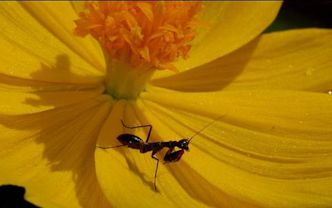



Odontomantis Asian Ant Mantis
$22.00 - $42.50
Odontomantis planiceps is a small mantis, with adult size ranging from 1.4 cm for males and 2.0 cm for females. It is commonly called the Asian ant mantis because it exhibits batesian mimicry in its juvenile stages, resembling black ants - most notably from the 1st to 3rd instar at which they are most vulnerable to predators.
Odontomantis planiceps is completely black from the 1st to 3rd instar, with green bands at the edges of every thorax segment.
After molting to the 4th instar and up to its ultimate molt, they are mostly green with some variation in color depending on the vegetation in which they reside.
Habitat
Odontomantis micans thrives in the captivating landscapes of India, Sri Lanka, Thailand, Sumatra, Borneo, and the Sunda Islands. These regions provide the ideal mix of bushes and damp warmth, creating the perfect setting for these enchanting creatures to flourish.
Sexing
Ant Mantises: A Sizeable Distinction
The distinction between males and females in the Ant Mantis (Odontomantis micans) goes beyond just appearance. Let’s delve into the world of these enchanting creatures and uncover the differences that define their lives.
Size Matters
Male: Standing at an average size of approximately 1.5cm, male Ant Mantises boast a modest stature. This diminutive size doesn’t diminish their significance, as their role in the mantis world holds its own charm.
Female: In contrast, female Ant Mantises take the stage with an impressive size of around 2.4cm. Their larger frame hints at the significant role they play in the continuation of their species.
Lifespan Insights
The timeline of a mantis’s life is a fascinating journey that reflects its growth and transformations:
| Comparison | Male | Female |
|---|---|---|
| Lifespan | Approximately five months | Approximately 6.5 months |
| Moltings | Six moltings | Seven moltings |
Sexing Methods
The ability to differentiate between male and female Ant Mantises is a skill that unveils the complexities of their biology:
Male Sexing:
-
L5 and Above: Males can be identified by counting the abdominal segments, which typically number 8.
-
Adults: Adult males are characterized by smaller and slender physiques than females. Once again, counting the abdominal segments serves as a reliable identifier.
Female Sexing: L5 and Above: Females stand out by having six abdominal segments, setting them apart from their male counterparts.
-
Adults: Fully grown female Ant Mantises are distinguished by their larger and more compact body structure. Counting the abdominal segments continues to be a reliable method of differentiation.
Behavior and care.'
While the aggression of Odontomantis micans towards prey and other mantises is relatively low, it’s essential to create an environment that supports their natural behavior. These creatures master the art of ant mimicry, both in appearance and action, underscoring the captivating complexity of the natural world.
Proper ventilation and prevention of stagnant moisture are crucial to their well-being. These considerations are vital for nurturing the intricate beauty and mimicry that define Odontomantis micans.
While the aggression of Odontomantis micans towards prey and other mantises is relatively low, it’s essential to create an environment that supports their natural behavior. These creatures master the art of ant mimicry, both in appearance and action, underscoring the captivating complexity of the natural world.




